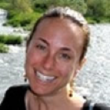Terrestrial 1: Difference between revisions
From CSDMS
No edit summary |
No edit summary |
||
| (29 intermediate revisions by the same user not shown) | |||
| Line 1: | Line 1: | ||
=Terrestrial Working Group= | |||
{{Member_welcome|Terrestrial Working Group}} | |||
==Co-Chairs== | |||
{| | |||
|- | |||
| width="320px"| '''Nicole Gasparini''' | |||
| align="left" width="250px" rowspan=7 |[[image:Ngasparini.headshot.png|110px]] | |||
| | |||
| width="320px"| '''Leslie Hsu''' | |||
| align="left" width="250px" rowspan=7 |[[image:LHsu-headshot.png|110px]] | |||
| | |||
|- | |||
| Tulane University | |||
| | |||
| US Geological Survey | |||
|- | |||
| Department of Earth and Environmental Sciences | |||
| | |||
| W 6th Ave Kipling St. | |||
|- | |||
| New Orleans, LA 70118 | |||
| | |||
| Lakewood, CO 80225 | |||
|- | |||
| Email: [mailto:ngaspari@tulane.edu ngaspari@tulane.edu] | |||
| | |||
| Email: [mailto:lhsu@usgs.gov lhsu@usgs.gov] | |||
|- | |||
| Phone: +1 504-862-3197 | |||
| | |||
| Phone: +1 303-202-4080 | |||
|- | |||
| | |||
| | |||
| | |||
|- | |||
|} | |||
== Introduction == | |||
The Terrestrial Working Group (''currently '''{{#ask: [[User:+]][[Working group member::Terrestrial Working Group]] | |||
| format=count | |||
}}''' members'') deals with erosion, sediment and solute transport, and deposition on land. The processes concerned are wide ranging, from the sculpting of glacial landscapes to the formation of soil and the transport of erosional materials to the coastline. | |||
The Group's working goals include: | |||
* Evaluate present knowledge of processes in terrestrial environments (mountains, plains, deserts, jungles, etc., as well as human impacts in these settings) and identify the numerical models presently in use. | |||
* Identify gaps in knowledge and areas where model development is needed. Such gaps include processes about which very little is known -- such as the dynamics of bedrock landscapes and the evolution of grain size populations -- and processes that are partly understood but for which numerical codes are under-developed. | |||
* Define and address interesting and relevant proof-of-concept questions. These are science questions that use the CSDMS paradigm to improve our understanding of landscape evolution and its links with the atmosphere, lithosphere, biosphere, hydrosphere, and cryosphere. Proof-of-concept questions range from decadal to geological in time scale, and from small watersheds to mountain ranges in spatial scale. | |||
* Work with the community to populate the CSDMS model toolkit with models and software tools of all types. These include large, multi-faceted landscape evolution models as well as simple, semi-analytical representations of a single process, hydrodynamic codes such as open-channel flow in 1D and 2D, tools for digital-terrain data processing, and a great many others -- any software, in fact, that can help the community better understand the dynamics of the earth's changing landscapes. | |||
==News Letter== | |||
* [[03_2019_TWG_newsletter|March 2019 News Letter]] | |||
* [[11_2018_TWG_newsletter|November 2018 News Letter]] | |||
* [[09_2018_TWG_newsletter|September 2018 News Letter]] | |||
== Terrestrial subgroups== | |||
* [[Wildfire_TWG-subgroup|Wildfire]] | |||
* [[Data_TWG-subgroup|Data]] | |||
* ...... | |||
==Terrestrial WG links== | |||
* [[Terrestrial Members|Members]] | |||
* [[Terrestrial meetings | Meetings & presentations]] | |||
* [[Terrestrial Reports|Reports]] | |||
== Announcements == | |||
No announcements at this point | |||
== Join == | |||
Do you want to become part of CSDMS? [[Special:RequestAccount | Please do so in joining a Working Group or Focus Research Group]]. | |||
Latest revision as of 11:03, 18 March 2019
Terrestrial Working Group
1 Login to find out if you are a member of the Terrestrial Working Group
Co-Chairs
| Nicole Gasparini | 
|
Leslie Hsu | 
|
||
| Tulane University | US Geological Survey | ||||
| Department of Earth and Environmental Sciences | W 6th Ave Kipling St. | ||||
| New Orleans, LA 70118 | Lakewood, CO 80225 | ||||
| Email: ngaspari@tulane.edu | Email: lhsu@usgs.gov | ||||
| Phone: +1 504-862-3197 | Phone: +1 303-202-4080 | ||||
Introduction
The Terrestrial Working Group (currently 1206 members) deals with erosion, sediment and solute transport, and deposition on land. The processes concerned are wide ranging, from the sculpting of glacial landscapes to the formation of soil and the transport of erosional materials to the coastline.
The Group's working goals include:
- Evaluate present knowledge of processes in terrestrial environments (mountains, plains, deserts, jungles, etc., as well as human impacts in these settings) and identify the numerical models presently in use.
- Identify gaps in knowledge and areas where model development is needed. Such gaps include processes about which very little is known -- such as the dynamics of bedrock landscapes and the evolution of grain size populations -- and processes that are partly understood but for which numerical codes are under-developed.
- Define and address interesting and relevant proof-of-concept questions. These are science questions that use the CSDMS paradigm to improve our understanding of landscape evolution and its links with the atmosphere, lithosphere, biosphere, hydrosphere, and cryosphere. Proof-of-concept questions range from decadal to geological in time scale, and from small watersheds to mountain ranges in spatial scale.
- Work with the community to populate the CSDMS model toolkit with models and software tools of all types. These include large, multi-faceted landscape evolution models as well as simple, semi-analytical representations of a single process, hydrodynamic codes such as open-channel flow in 1D and 2D, tools for digital-terrain data processing, and a great many others -- any software, in fact, that can help the community better understand the dynamics of the earth's changing landscapes.
News Letter
Terrestrial subgroups
Terrestrial WG links
Announcements
No announcements at this point
Join
Do you want to become part of CSDMS? Please do so in joining a Working Group or Focus Research Group.
